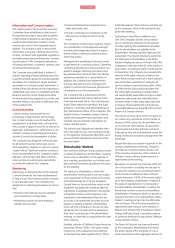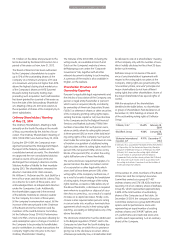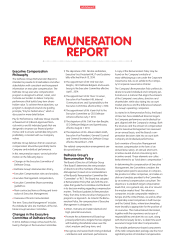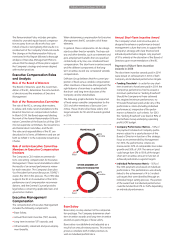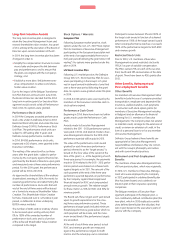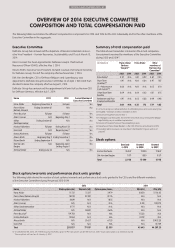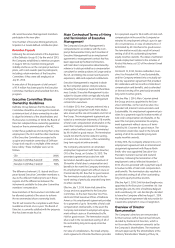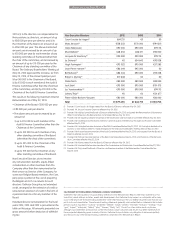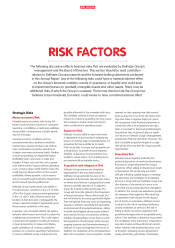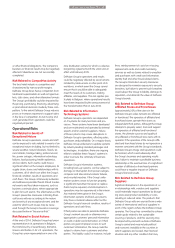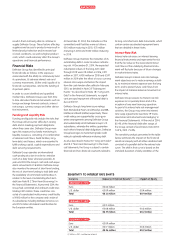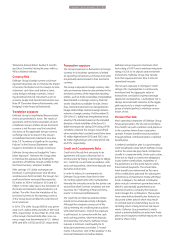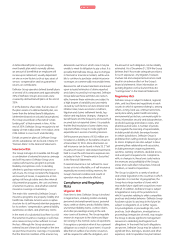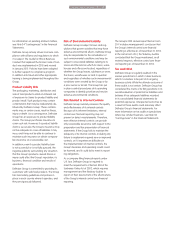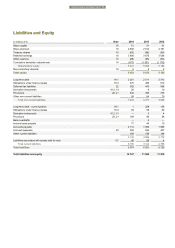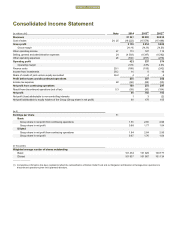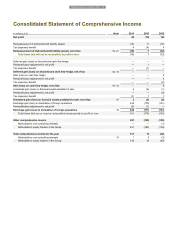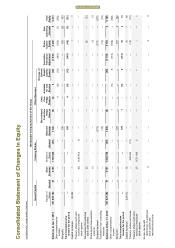Food Lion 2014 Annual Report Download - page 68
Download and view the complete annual report
Please find page 68 of the 2014 Food Lion annual report below. You can navigate through the pages in the report by either clicking on the pages listed below, or by using the keyword search tool below to find specific information within the annual report.
RISK FACTORS
result in them not being able to continue to
supply Delhaize Group. These factors affecting
suppliers and access to products may result in
limited product selection and increased out-
of-stock conditions, as well as higher product
costs, which could adversely affect the Group’s
operations and financial performance.
Financial Risks
Delhaize Group has identified its principal
financial risks as follows: (i) the exposure
associated with the ability to continuously fund
its operations, (ii) adverse interest rate and
currency movements, (iii) the credit quality of its
financial counterparties, and (iv) the funding of
its pension plans.
In order to cover identified and quantified
market risks, Delhaize Group uses from time
to time derivative financial instruments such as
foreign exchange forward contracts, interest
rate swaps, currency swaps and other deriva-
tive instruments.
Funding and Liquidity Risk
Funding and liquidity risk include the risks that
the Group will encounter difficulty in raising
debt and in meeting payment obligations
when they come due. Delhaize Group man-
ages this exposure by closely monitoring its
liquidity resources, consisting of a combination
of retained cash flows, bank facilities, long-
term debt, and leases, which are essential to
fulfill working capital, capital expenditures and
debt servicing requirements.
Delhaize Group operates an international
cash-pooling structure in order to centralize
cash on a daily basis wherever possible. At
year-end 2014 the Group’s cash and cash equiv-
alents amounted to €1.6 billion. Delhaize Group
also monitors the amount of short-term funding,
the mix of short-term funding to total debt and
the availability of committed credit facilities in
relation to the level of outstanding short-term
debt (see Note 18.2 “Short-term Borrowings” in
the Financial Statements). At year-end 2014, the
Group had committed and undrawn credit lines
totaling €525 million. These credit lines con-
sisted of a syndicated multicurrency credit facility
of €400 million for the company and certain of
its subsidiaries including Delhaize America, LLC
and €125 million of bilateral credit facilities for
the European entities.
At December 31, 2014, the maturities of the
committed credit facilities were as follows:
€50 million maturing in 2015, €75 million
maturing in 2016 and €400 million maturing
in 2019.
Delhaize Group monitors the maturities of its
outstanding debt in order to reduce refinanc-
ing risk. At December 31, 2014, the expected
redemption values of the long-term debt
through 2019 were €8 million in 2016, €371
million in 2017, €400 million in 2018 and €247
million in 2019 after the effect of cross-currency
interest rate swaps and before the impact
from the cash tender offer settled in February
2015, as detailed in Note 35 “Subsequent
Events.” As described in Note18.1 ”Long-term
Debt” in the Financial Statements, no signifi-
cant principal repayment of financial debt is
due until 2017.
Delhaize Group’s long-term issuer ratings
from Standard & Poor’s and Moody’s are BBB-
(stable) and Baa3 (stable) respectively. These
credit ratings are supported by cross-guar-
antee arrangements among Delhaize Group
and substantially all of Delhaize Group’s U.S.
subsidiaries, whereby the entities guarantee
each other’s financial debt obligations. Delhaize
Group leverages its investment grade credit
rating to optimally refinance maturing debt.
As also described in Notes 18.1 ”Long-term Debt”
and 18.2 “Short-term Borrowings” in the Finan-
cial Statements, the Group is subject to certain
financial and non-financial covenants related to
its long- and short-term debt instruments, which
contain certain accelerated repayment terms
that are detailed in these Notes.
Interest Rate Risk
Interest rate risk arises on interest-bearing
financial instruments and represents the risk
that the fair value or the associated interest
cash flows of the underlying financial instru-
ment will fluctuate because of future changes
in market interest rates.
Delhaize Group’s interest rate risk manage-
ment objectives are to reduce earnings volatil-
ity, to minimize interest expense over the long
term, and to protect future cash flows from
the impact of material adverse movements in
interest rates.
Delhaize Group reviews its interest rate risk
exposure on a quarterly basis and at the
inception of any new financing operation.
As part of its interest rate risk management
activities, the Group may enter into interest
rate swap agreements (see Note 19 “Deriv-
ative Financial Instruments and Hedging” in
the Financial Statements). At the end of 2014,
80.4% of the financial debt after swaps of
the Group carried a fixed interest rate (2013:
74.3%; 2012: 75.8%).
The sensitivity analysis presented in the table
below estimates the impact on the financial
results and equity (with all other variables held
constant) of a parallel shift in the interest rate
curve. The shift in that curve is based on the
standard deviation of daily volatilities of the
SENSITIVITY TO INTEREST RATE SHIFTS
Currency Impact on Financial Results(1) Impact on Equity
DECEMBER 31, 2014
Euro €0.04 million -
U.S. dollar €0.09 million €0.4 million
Total €0.13 million €0.4 million
DECEMBER 31, 2013
Euro €0.11 million -
U.S. dollar €0.08 million €0.2 million
Total €0.19 million €0.2 million
DECEMBER 31, 2012
Euro €0.09 million -
U.S. dollar €0.17 million €0.2 million
Total €0.26 million €0.2 million
(1) Within a 95% confidence interval.


